3D printing is firmly established in today’s dentistry industry. Whether in-office or at a major dental lab, 3D printers are revolutionizing many aspects of dental care and manufacturing ranging from the fast, accurate printing of dental models for education to more economical, customized full dental prosthetics and restorations.
With chair-side production of try-ins, custom trays, temporary crowns, and surgical guides among other products, 3D printing accelerates service and puts local dentists in full control of patient-specific products. The ability to produce parts from 3D scans and digital files, means fewer appointments, faster turnaround times, and vastly lowered costs, resulting in an overall improvement in patient care.

But if you’re here, you’re already sold on the benefits on 3D printing. Let’s take a look at the growing selection of 3D printers that can bring your practice or lab into the era of digital dentistry.

Which Type of Dental 3D Printer Fits Your Needs?
As a dental practitioner or a specialist in a dental laboratory, you know that there’s a world of difference between dental models for patient education and dental parts for patient use.
If your goal is to print reasonably accurate models of a patient’s mouth taken from an oral 3D scan or impression in order to, for example, explain a procedure to a patient, then there’s no need for a specialized dental printer. In fact, you have a much wider range of printers to choose from for model making than you do for printing parts that will come in contact with a patient.
However, if you’re looking to print biocompatible dental parts – anything that will come in contact with a patient’s mouth or skin, such as clear aligners, veneers, temporary or permanent replacement teeth, or dentures – you’ll need to use biocompatible materials certified by the regulatory authorities in your area, such as FDA in the US, CE in the EU, KFDA in South Korea, etc., plus approved software and 3D printers. This is our focus in this article.

Specialty Dental 3D Printers Companies
Because there are numerous regulations related to medical devices, it pays to work with a 3D printer manufacturer that specializes in the dental market (either entirely or as a large focus of their business). These companies offer practical expertise and support, along with an ecosystem of dental-focused products and services, plus a continuous supply of necessary consumables. Many have dental and orthodontic practitioners on staff.
Fortunately, there’s a growing number of 3D printing companies specializing in the dental market, including:
There are also dental equipment companies that have developed their own 3D printers and materials, including:
- Kulzer
- DMG America
The 3D Printing Technology Learning Curve
Adding 3D printing to your dental practice or lab requires that you learn new techniques, technologies, materials, and processes, so naturally, without sufficient training and support, you’re unlikely to get the most out of your printer investment. Choose your vendor carefully. All of the companies we feature below offer full ecosystem support for dental professionals.

Many 3D printer manufacturers offer dental solutions that include service plans, such as personalized onboarding, proactive check-ins, and phone and email support, along with resource libraries of guides, videos, and tutorials. Several 3D printer manufacturers, such as SprintRay and Kulzer, focus exclusively on digital dentistry, offering a comprehensive approach and promising a smooth integration between dental printing software, printers, accessories, materials, and support.
How Are Dental Parts 3D Printed?
To illustrate how the components in digital dentistry work together, here’s a quick overview of the workflow to make a patient-specific dental night guard in-office.
It starts with the digital scan of the patient’s mouth with a hand-held intraoral scanner, external scanner, or the scan of a traditional plaster dental cast or model.
From there, your digital images are uploaded to computer aided design (CAD) software specific to the dental industry, such as Exocad or the software that comes with your 3D printer. There’s a wide range of dental CAD programs that will integrate with most major 3D printer brands. Choose the software that best matches your (and your staff’s) skill level.
Next, if your dental software doesn’t do this automatically (and most do), you’ll upload your design files to “slicer” software that either comes with your printer or is compatible with it. The slicer transforms your digital model into 3D printing instructions for the printer.
Once your night guard is printed in certified biocompatible resin, it requires some cleaning to remove any residue, removing the supports, and curing in light to harden fully. The last step is typically some polishing and it’s ready for the patient to try on. Depending on your printer, the entire process could take a few hours.
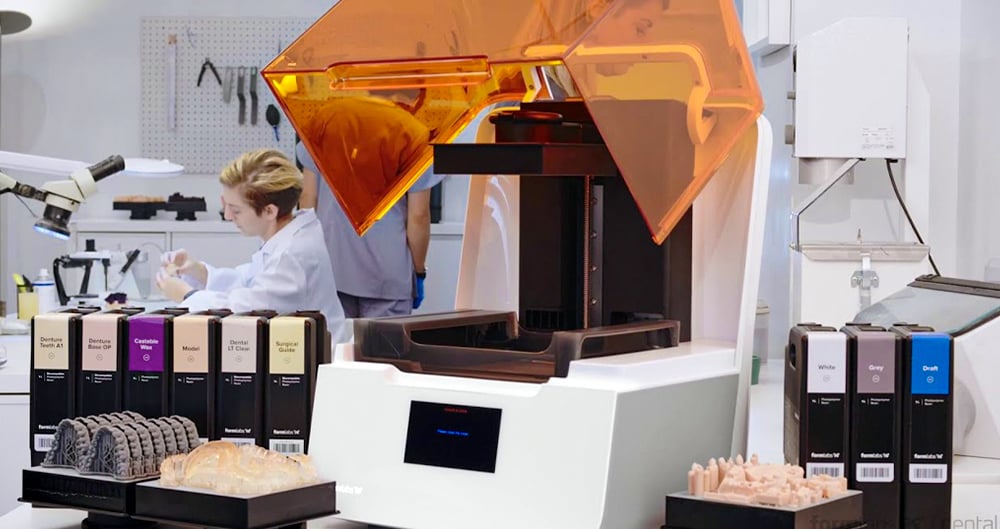
Criteria for Top Dental 3D Printers
Your choice of printer for biocompatible dental parts depends on a variety of factors including what you intend to print, how much you intend to print per day or week, how fast you need your parts, your budget, and how automated or easy-to-use you want the process to be. Are you just getting started or are you expanding or upgrading your operations?
You’ll also want to consider the level of service and support from your manufacturer and which dental software the printers are compatible with. Most manufacturers will send you a sample print, so be sure to request one to evaluate whether it meets your expectations for details, surface finish, and strength.
When asked to rank key purchase criteria for selecting the 3D printer brand their lab uses most, dental pros responding to a survey by printer manufacturer Carbon, said: accuracy, reliability and maintenance, return on investment, total cost of ownership, quality of materials, and lowest price topped the list.
Let’s take a detailed look at the top digital dentistry solutions in the industry. All of the printers on our list offer biocompatible materials.
Scroll to the bottom for a look at materials and post-processing equipment.
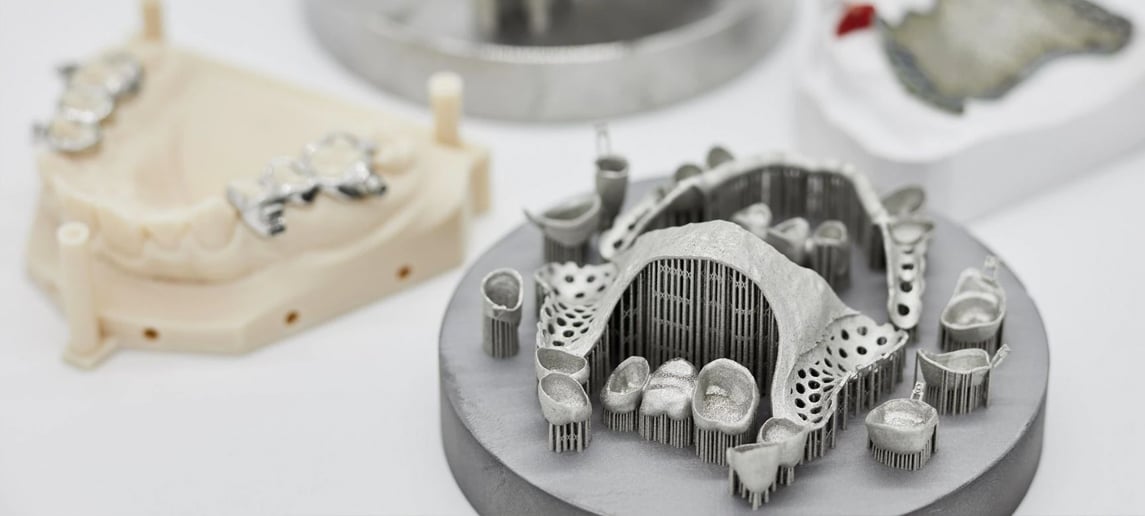
| Brand | Print Types | Printer | Technology | Price Range |
|---|---|---|---|---|
| Zortrax | Models, patterns for crowns and bridges, clear aligners, surgical guides, occlusal splints | Inkspire | LCD | $2,000 |
| Shining 3D | Models, wax-ups, surgical guides, gingiva, customized impression trays, bracket transfer trays | AccuFab-L4D, AccuFab-D1s | DLP | $3,000-$6,500 |
| Formlabs | Models, aligners, surgical guides, occlusal splints, denture bases, denture teeth | Form 3B+, Form 3BL | SLA | $4,000-$14,000 |
| Desktop Health | Models, surgical guides, provisional restorations, removable partials, wax-ups, temporary crowns and bridges, castable parts | Einstein Series | DLP | $8,999-$34,999 |
| SprintRay | Models, surgical guides, custom night guards, crowns, copings, bridges, RPDs | Pro95 S, Pro55 S | DLP | $8,995 |
| Rapid Shape | Models, surgical guides, provisional restorations, removable partials, wax-ups, temporary crowns and bridges, castable parts | D10, D20, D30, D40, D70, D90, D100 | DLP | $10,000-$50,000 |
| Asiga | Models, dental orthodontics, crown and bridge, surgical guides, custom trays, partial dentures, clear dental splints, castable parts for crown and bridge and frameworks | Max series, Pro 4K series | DLP | $10,000-$30,000 |
| 3D Systems | Models, denture bases, castable parts, custom trays, surgical guides, orthodontic splints, crowns and bridges, removable frameworks, crown and bridge copings | NextDent 5100, ProX 800 for Dental, ProJet MJP 2500 Plus for Dental, ProJet MJP 3600 Dental, DMP Dental 100 | LCD, Metal LPBF | $12,000-$215,000 |
| Carima | Models, surgical guides, provisional restorations, removable partials, wax-ups, temporary crowns and bridges, castable parts | IMD | DLP | $12,000 |
| Kulzer | Night guards, custom impression trays, surgical guides, models, CAD-to-cast structures | Cara Print 4.0 | DLP | $15,000-$20,000 |
| Stratasys | Models, surgical guides, night guards, castable partial denture frameworks, try-ins for veneers and dentures, orthodontic appliances, custom trays | J5 DentaJet, Objet30 Dental Prime, Stratasys J700 & J720 Dental, Origin One Dental | Material Jetting, DLP | $100,000-$250,000 |
| Nexa3D | Models, surgical guides, gingiva, customized impression trays, bracket transfer trays | Xip, XipPro, NXD400 | LCD | $30,000 |
| Carbon | Models, denture bases, carded teeth, splints, night guards, surgical guides, temporary crowns and bridges, trays, gingiva masks | L1, M2, M2d | DLP | $50,000-$100,000 |
| DMG | Surgical guides, burn-out casting molds, mouth guards, occlusal splints, crowns and bridges, physical models | 3Demax | DLP |
Zortrax

Zortrax is a resin printer the company boasting a plug-and-play device with an interface that makes it easy to operate even without prior 3D printing experience. Appliances, including dental crowns, bridges, and surgical guides, can be 3D printed directly with Zortrax’s own biocompatible resins or a range of compatible third-party materials. Castable resins are available for making investment patterns for casting dental alloys.
Zortrax Inkspire works with dedicated Zortrax resins but is fully compatible with all 405 nm photopolymers. Resolution is 50 microns with a 25-micron layer height.
Accompanying the hardware is Zortrax’s own software, Z-Suite, which is a dedicated slicing and 3D printing farm (multi-printer) management software that comes free with every printer. Z-Suite is compatible with popular dental CAD/CAM software solutions, including inLab CAD SW 18 and ZFx Dental CAD Design Software. Zortrax Inskpire can also work with third-party slicers.
Shining 3D
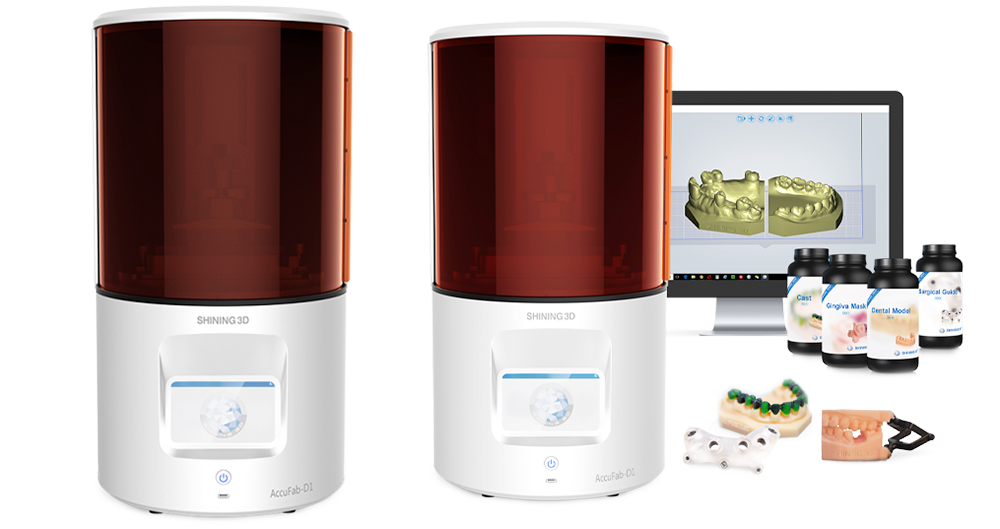
Shining 3D – probably best known for its 3D scanners – is another company offering a fully integrated 3D digital dental solution from obtaining 3D data with 3D scanners for lab and intraoral 3D scanners for clinics, then designing with professional dental CAD software, to printing dental products, including working models, orthodontics models, implant models, surgical guides, wax-ups, and partial frameworks.
The company’s DLP 3D printer AccuFab-D1s offers users an intuitive and user-friendly workflow with fast print speeds and high accuracy. With diverse resin material options, it can meet demands in restorative, implant and orthodontic applications. Featuring a large build volume and a print speed of up to 50mm/h, the AccuFab-D1s is able to print 4 arch models in an hour and multiple surgical guides in less than 30 minutes.
New in 2023 is Shining 3D’s resin print washer. The FabWash is a fully-automated multi-stage part-release, wash, and dry solution that can be programmed for each material. FabWash is also equipped with Wi-Fi enabling over-the-air updates to deploy the latest firmware and material library.

Formlabs
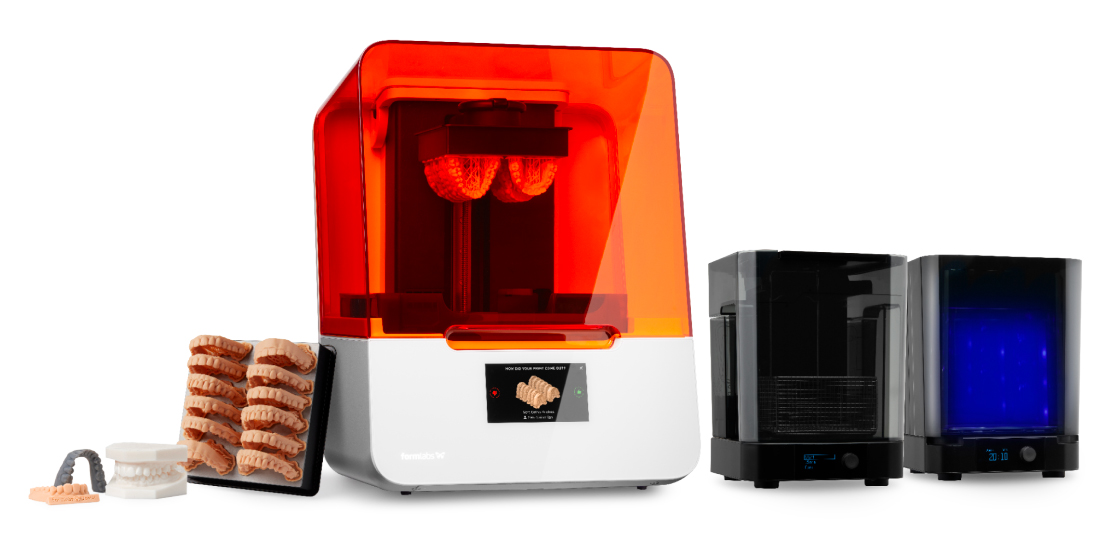
The Formlabs Form 3B+ is the company’s dedicated machine for dental and healthcare applications). It feature Formlabs’ own low-force stereolithography technology that prints fine-detailed parts at a 100-micron resolution.
In 2023, Formlabs unveiled several new dental products aimed at increasing efficiency, speed, and ease of use of the entire dental workflow, the company said.
The new Fast Arch Printing feature, for example, is a print setting that can improve print times by up to 120%, the company says. A single arch printed in Draft V2 resin at 200 microns takes just 8 minutes. One Form 3B+ can now produce 330 arches at 200 microns layer height or 200 arches at 100 microns layer height within 24 hours when used together with the new Form Auto.
Form Auto is Formlabs new hardware extension that automatically removes finished parts from the build platform and deposits them in a holding bin, ready for the Form Wash, then starts the next print.

Formlabs also introduced a new post-processing curing unit that cures dental indications 90% faster than the standard Form Cure. There’s also a new feature in the Formlabs dental print preparation software that lets you automate more workflows and create pre-set orientation and support settings for each dental indication.

Desktop Health

3D printer maker Desktop Metal has two 3D printers aimed at the dental market through its Desktop Health wing. The audaciously named Einstein series is “fit for a genius”, the company says, and comes in a desktop and a laboratory size. Both are DLP printers compatible with a wide range of dental resins.
3D printer maker Desktop Metal has two 3D printers aimed at the dental market through its Desktop Health wing. The audaciously named Einstein series “fit for a genius”, the company says, comes in a desktop and a laboratory size. Both are DLP printers compatible with a wide range of dental resins.
The desktop version has a generous 190 x 107 x 102-mm build volume and a 25-micron minimum layer height. The larger Einstein Pro XL has a 249 x 140 x 165-mm build volume and is qualified to print Flexcera Smile Ultra+, an FDA 510(k) cleared Class II material for permanent and temporary dental restorations, including veneers, inlays/onlays, crowns, bridges, and dentures.
Desktop Health doesn’t make its own post-processing machines but partners with companies that do so you can have the full ecosystem from one shop.
SprintRay
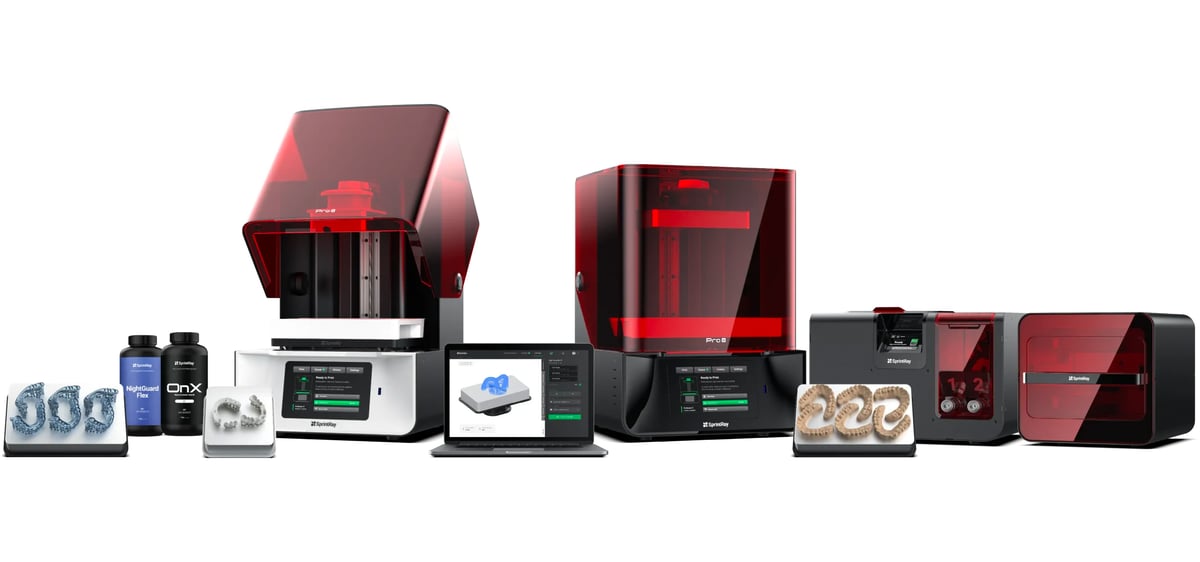
SprintRay only makes dental 3D printers. In January 2022, SprintRay introduced its latest machine, the Sprintray Pro S. According to them, the printer does everything its predecessors did, only faster and better. The Pro S comes with improvements like a consumables manager, dual heating, and 10% higher print accuracy.
It can be purchased in two configurations, the Pro 95 S and Pro 55 S, where the 95 and 55 stand for their respective micron resolution in XY. Each printer is offered together with a resin bundle for $ 8,995 on their website.
In April 2022, SprintRay launched ceramic-filled hybrid material SprintRay Crown to enable the on-site production of 3D printed crowns with as little as $2 in material cost. The material is FDA 510(k) cleared, and , according to Sprintray, “following recent ADA amendments [[in 2023]], dental professionals now have the ability to seek reimbursement for 3D-printed ceramic crowns containing >50% inorganic refractory compounds—marking a major milestone in the evolution of 3D printing for restorative dentistry.”
The company’s cloud-based design and treatment management software can guide you right from the planning stage through the post-processing for a plug-and-play experience.
Using third-party CAD/CAM treatment-planning software and SprintRay Pro, dental professionals can design and 3D print surgical guides in under 30 minutes, responding quickly to patient needs, the company says.
Rapid Shape
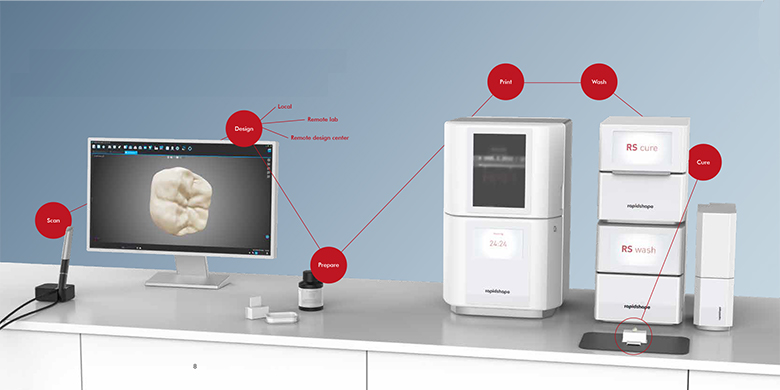
Rapid Shape is another 3D printer maker that is primarily focused on dental applications, although it also serves jewelry and industrial sectors. It offers a wide array of desktop printers for dental offices and large production printers for dental labs. The smaller office printers, such as the D10+ and D20+, enable onsite 3D printing without specialist knowledge, the company says.
The D20+ features a mess-free resin cartridge and reservoir but can be upgraded to an open material system. The larger and more feature-rich D3, D40, D70, D90, and D100 offer dental labs more speed and automation.
In addition to its proprietary materials, Rapid Shape partners with known material manufacturers, such as Dreve, Kulzer, BEGO, and Keystone Industries to offer a range of biocompatible resins.
In 2023, the company launched an extra large curing device, the RS cure XL, that can cure dozens of parts in approximately 6 to 10 minutes depending on the material.
Asiga
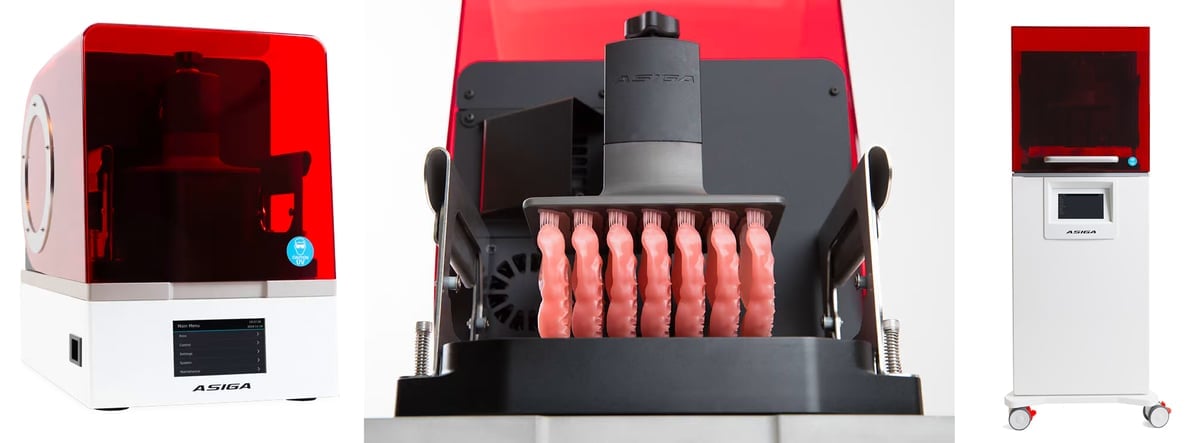
From restorative dentistry through to orthodontic devices, Asiga 3D printers boast repeatable accuracy for production continuity and patient safety. There are two dental practice desktop size printers, the Max and Max X, and two labratory 3D printers, the Pro 4K and Pro 4K XL.
In contrast to 3D printer manufacturers that restrict users to their proprietary materials, Asiga does make their own dental materials but also accommodate a broad spectrum of third-party resins.
The Aisga’s software can connect with a range of computer operating systems and 3D model file formats, including Exoprint from Exocad and 3Shape Implant Studio. The integrated PC can manage multiple builds at the same time, and offers a range of user-friendly features, as well as a lifetime of free software updates.

3D Systems
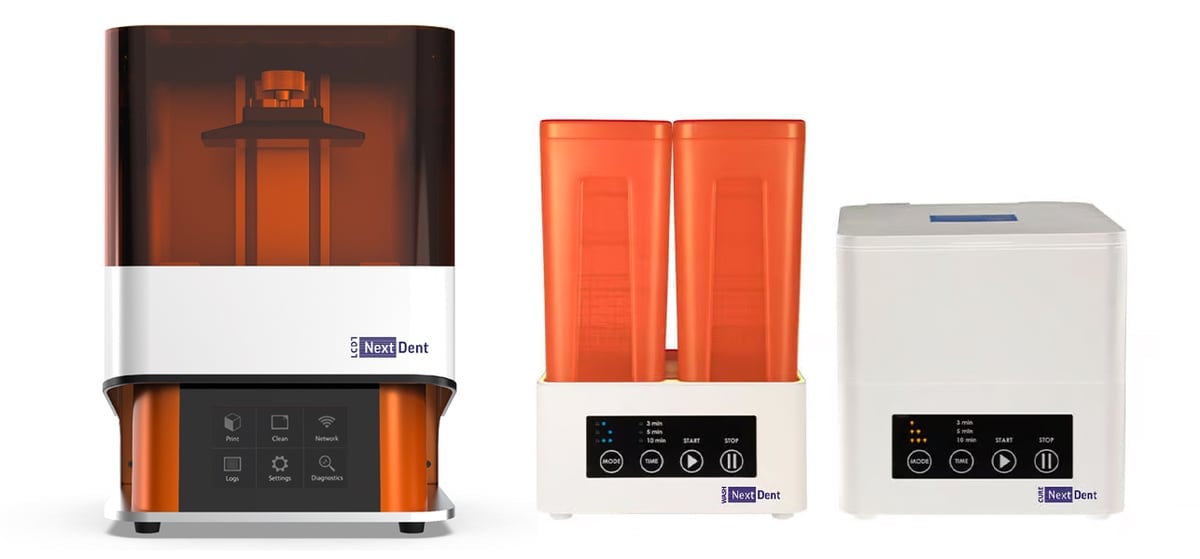
3D Systems, one of the world’s largest 3D printing companies with a vast portfolio of machines and materials, reentered the desktop size dental 3D printer market in 2023 with its smallest 3D printer, the NextDent LCD1. 3D Systems is squarely addressing the accessibility hurdle in dental 3D printing with this entry-level machine, which it hopes will create life-long 3D Systems customers who move up to the company’s other, larger dental machines as their practices expand.
The NextDent LCD1, as you might guess, features LCD (liquid crystal display) technology, also called masked stereolithography (MSLA), which is uncommon among dental 3D printers. It’s faster than other types of resin 3D printing. The LCD1 has a print speed of 4.5 cm per hour, an XY resolution of 49 μm, and a small layer height (30 – 150 μm).
All resin 3D printing requires post-process washing and curing parts. The NextDent LCD1 has companion machines to handle these tasks.
The company’s large NextDent 5100 printer is for high-speed 3D printing for production of dental appliances and castings, and delivers precise results with minimal human intervention, the company says. Combine the printer with other 3D Systems dental solution components to create a comprehensive workflow. This includes the NextDent LC-3DMixer for optimal stirring of materials and the NextDent LC-3DPrint Box for UV post-curing.

Carima

Carima is the leading dental specialists in South Korea offering dental 3D printing solutions, including dental resins, and curing hardware. They offer a practical, same-day digital workflow solution centered around their IMD dental 3D printer and dedicated curing station.
The Carima IMD 3D printer is specially designed for dental and medical applications. Carima uses DLP (digital light processing), a sub-type of stereolithography technology that involves curing a liquid resin. This technique is faster than laser-based stereolithography, in which a laser selectively solidifies resin spot by spot.
Carima provides a range of CE-certified and FDA-approved materials for all use cases. Nonetheless, its open parameters enables users to work with all kinds of third-party resins.
The printer is relatively lightweight and works silently for chair-side operation.
For larger production of dental parts, Carima offers the DM400 3D printer with a unique take on DLP, the company says is faster and cheaper. An entire build plate with, for example, 57 dental pieces, can be printed in just over an hour and a half. It can also 3D print larger, heavier parts because of its top-down DLP configuration.
Kulzer
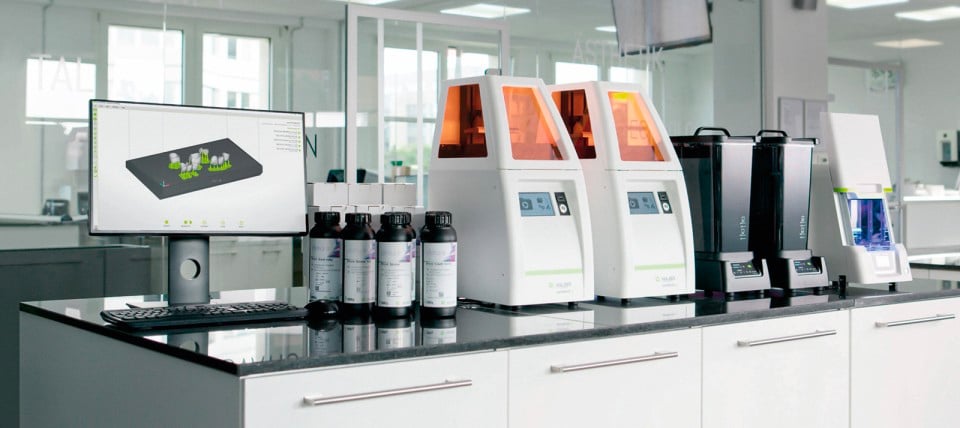
Kulzer is one of a handful of dental product suppliers to branch off into 3D printers. The company’s Cara Print 4.0 3D printer is billed as an economical method of producing polymer-based dental appliances in-house. Not only does it provide a cost-effective alternative to milling for certain indications, it is more competitively priced than other 3D printers on the market, while still meeting all the accuracy requirements, the company says.
The Cara Print 4.0 automatically adapts print speed according to the accuracy requirements of the current layer, often reaching speeds in excess of 100 mm/hour. The ability to vary layer thickness means that you can select the optimal balance of accuracy and speed. This makes it possible to optimize the process for appliances that don’t have high accuracy requirements (e.g. impression trays) by increasing the layer thickness and thereby reducing build time.
The printer software works with the CAD software of your choice, such as Cara CAD , Dental System (3Shape), DentalCAD (exocad) or DWOS CAD (Dental Wings).
Stratasys
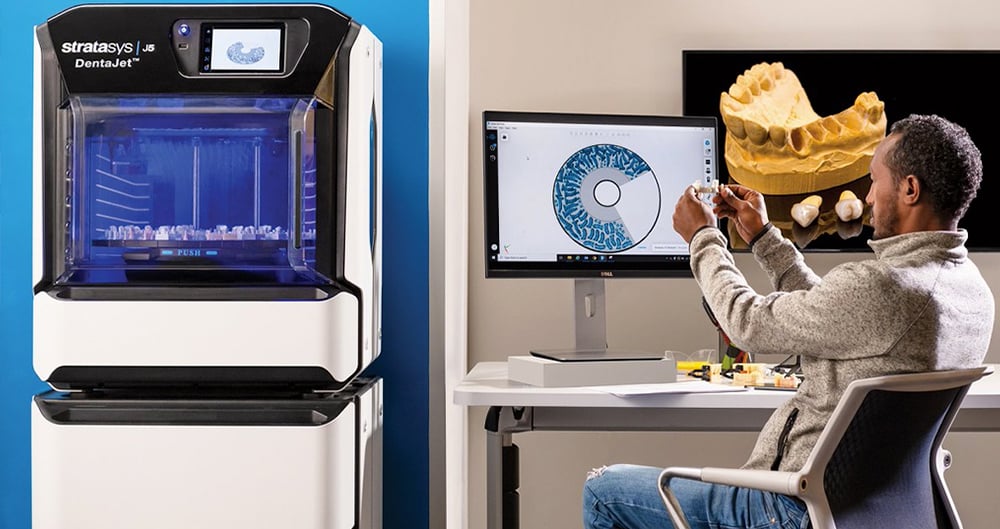
Stratasys is a global player in 3D printing, with a major focus on the dental care industry. The company offers a range of industrial PolyJet multi-material, multi-color printers ranging from the J5 DentaJet to the J700 Dental for large laboratories.
In 2023, Stratasys launched a new material that produces full-color, natural-looking dentures in a single piece ready for patients to wear.
The advantage of the new resin (compatible only with Stratasys J5 DentaJet 3D printer), the company says, is its ability to print volume batches of dentures where each one is patient-specific based on individual dental scans.
As a monolithic solution, there is no assembly, something that’s uncommon compared to other 3D printed denture solutions. Often, the gums of the denture are 3D printed in one material, while the teeth are printed in another and then assembled.
The J5 DentaJet is for customers looking to print high volumes of accurate dental models. Unique on our list, the J5 DentaJet can print soft and hard materials at the same time. For example, you could print a rigid opaque model, a soft gingiva mask, and a biocompatible transparent surgical guide all at the same time.
The J5 DentaJet comes with a full range of biocompatible dental resins, including a clear, flexible one, VeroGlaze opaque white for temporary in-mouth placement, VeroDent PureWhite, CMY resins for color, and a clear resin. Additionally, the Separator digital material coats dental models automatically in order to simplify the process of separating the acrylic device from the model, and then removing the wax and residue.

Nexa3D
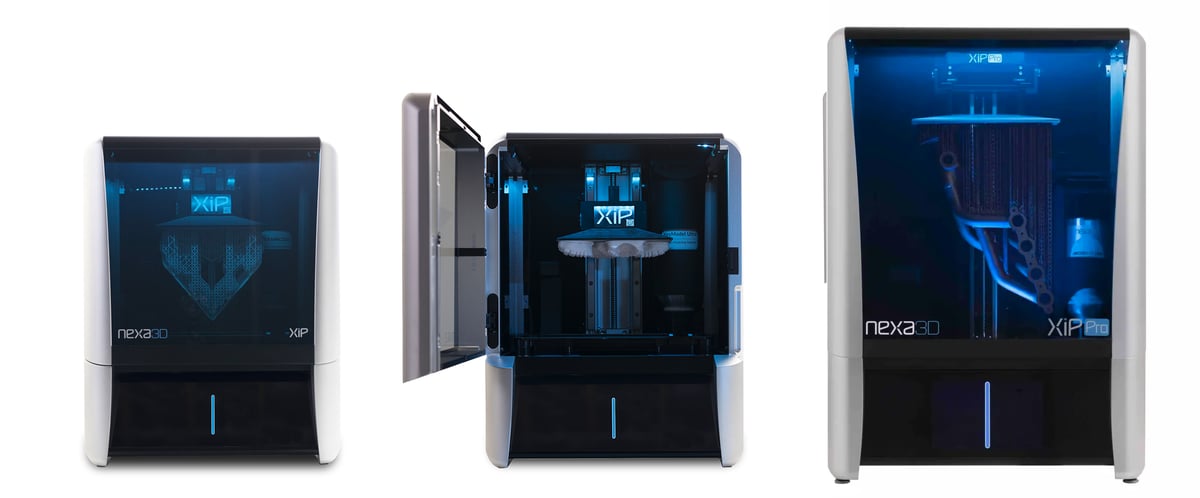
Although Nexa3D no long has a dedicated dental printer, its two new Xip machines more than make up for the loss of the older NXD200 in terms of price, volume, and speed.
The XiP Pro ($60,000) delivers the high production throughput at the low cost of operation, the company says, offering a 19.5-liter build volume and fastest print speed. The Pro is a 7K resolution LCD printer with 46-micron pixel size and 23-micron sub-pixel resolution. The smaller Xip ($7,000) is desktop size and can print 10 dental models in 30 minutes.
Nexa3D also offers its industrial NXE 400Pro for dental labs.
New in 2023, Nexa3D released two new dental resins. xDENT201 is a fastest-printing modeling resin designed for orthodontic models, yielding up to 10 flat models in just 20 minutes. The new DENT341 is a high-resolution material designed for 3D printing removable die models that has a 93% dimensional accuracy at only a 50 micron deviation.
Nexa3D also partners with dental materials developer KeyStone Industries to offered a full suite of specialist 3D printing resins, including the certified KeySplint Soft and KeyModel Ultra for dental and orthodontic models, as well as the KeyGuide and KeyTray materials for surgical guides and custom impression trays.
On the software side, the printers are fully compatible with the company’s DentFlow build preparation software that can prep a full day’s worth of prints, saving time and eliminating complexities typically associated with file prep and pre-processing workflows.

Carbon
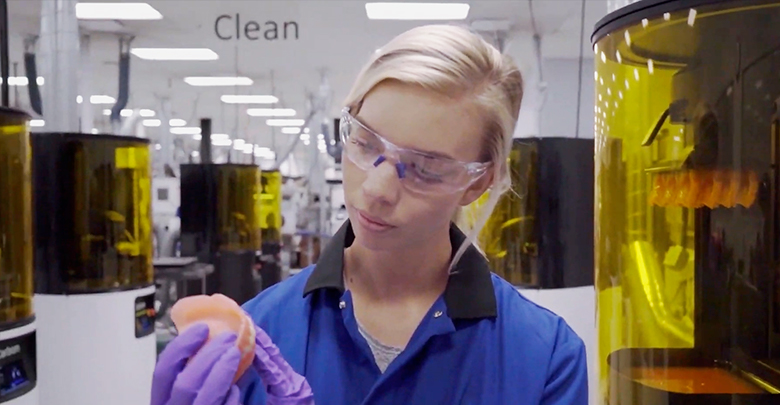
Carbon is unique among resin printers because of its proprietary Digital Light Synthesis (DLS) technology that combines high-resolution with rapid printing. Dentists in Carbon’s case study report being able to create full dentures in as little as 24-hours.
Carbon’s software is compatible with leading CAD/CAM software for dental practices and labs, such as 3Shape, exocad, and AvaDent. Materials from Carbon include FDA-approved resins for dental splints and night guards, and the company has initiated a program to develop a fully recyclable resin for dental models.
The larger L1 printer is a production solution for clear aligner models.

DMG
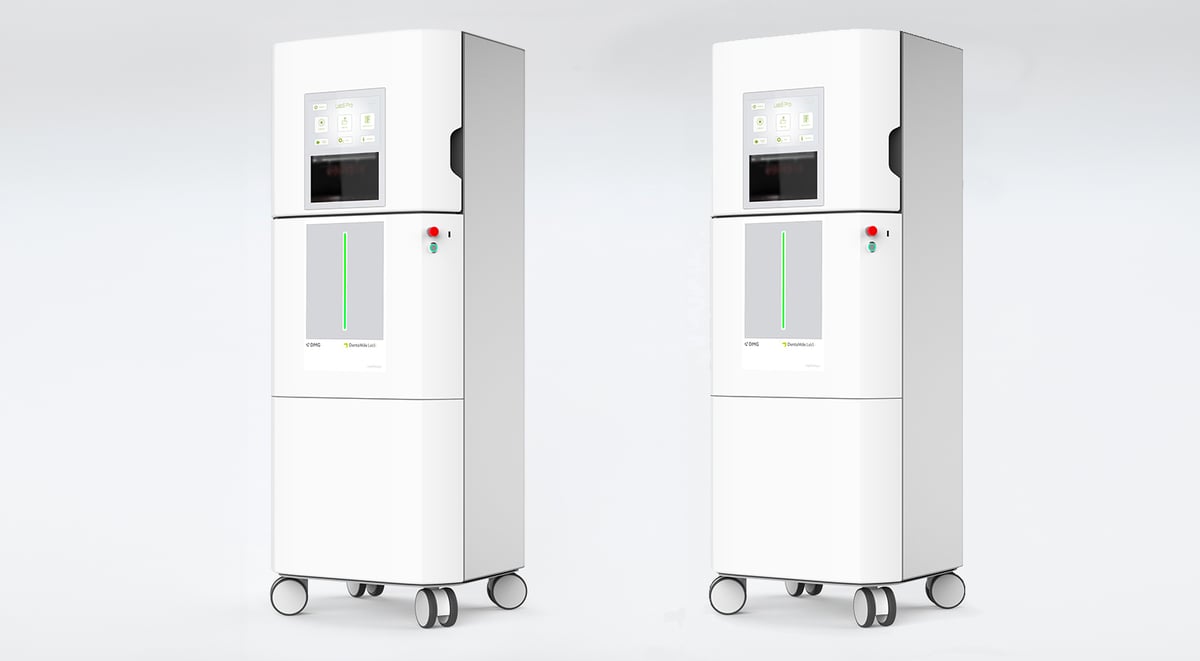
Dental products manufacturer DMG has also ventured into the digital dentistry sector with the release of their DMG DentaMile 3D Digital Printing Solution. The offer consists of a DLP printer, a washing and curing station, as well as a cloud-based digital workflow solution called DentaMile connect.
In 2023, the company launched two new DLP 3D printers aimed at dental laboratories for high-volume output.
The DentaMile Lab 5 and DentaMile Lab 5 Pro both have a large build platform, a high-precision 4K light source, fast print speeds, and connectivity with the DMG’s post-processing units, the 3Dewash and 3Decure.
For labs wanting a more automated solution, the Pro version offers an automated separation module and a resin reservoir refill. Following print jobs, parts are automatically separated from the build platform via a blade and deposited into a collection basket. The resin reservoir is then automatically refilled and ready for your next print job.
DMG also offers a range of resin materials fit for various dental applications like models, surgical guides, orthodontics, molds, splints, and gingival masks. These materials are also validated on other 3D printer providers on this list, including RapidShape and Asiga, showing their firm position in the sector even before releasing their own printer.
The decision for an established manufacturer of traditional dental products to also provide full-scale 3D printing solutions definitely makes for an interesting contender in the digital dentistry realm.
Metal 3D Printers for Dental Applications

Metal 3D printing has been used in dental labs for only about a decade but already, it is showing promise as a faster and less expensive way to fabricate custom crowns and bridges, which are then finished with ceramic), and dentures using cobalt chrome and titanium.
Just as polymer 3D printer makers have branched into dental, so to are metal 3D printer makers targeting this market as the next breakthrough technology for digital dentistry.
Metal 3D printer makers serving the dental market include:
Dental 3D Printing Technology DLP vs SLA
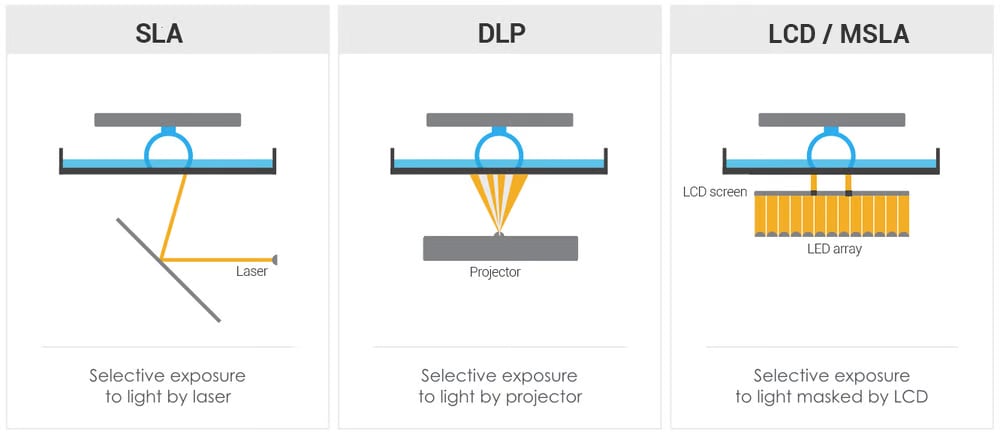
Although there are more than a dozen types of 3D printing technology, only a few are used in dentistry. Because the application requires highly precise and accurate parts, practitioners rely on resin 3D printing also known as vat polymerization. This technology, with subcategories including digital light processing (DLP), stereolithography (SLA) and liquid crystal display (LCD), uses a liquid resin cured by light to form a final part.
There’s also material jetting, which is another resin technology. It enables multicolor realistic looking parts. One example the PolyJet printer from Stratasys.
Practitioners are split between the two major resin 3D printing technologies, DLP and SLA. DLP is faster but some SLA machines offer more resin variety. For an in-depth overview of the differences, visit our guide linked below:
Materials

Many printer manufacturers work in conjunction with these material manufactures above to brand their own resins with properties that match the demands of their specific printers. But not all resins are interchangeable. Your printer will come with a list of tested and validated brands. If you use a material outside of this list you may not achieve the print quality or speed that’s typical of your printer.
Of course, any material for use in a patents mouth must be certified biocompatible in your region (by the FDA, CE, etc.). In addition to this certification, look for materials that meet ISO (International Standards Organization) levels for impact, strength, fracture-resistance, and stain-resistance.
Post Processing Equipment

Although a dunk in a simple dish of isopropyl alcohol (IPA) may suffice for washing most prints and curing could be done with sunlight or an inexpensive UV lamp, for interoral parts, a closed, automated approach is cleaner and more efficient.
Several printer manufacturers offer the washing and curing equipment necessary for final parts. Buying your accessories from the same manufacturer as your printer ensures easy integration, but you’re not locked in. Many accessory brands are interchangeable. The more sophisticated your printer, the easier the wash and cure process is, and many industrial printers incorporate printing, washing, and curing into a single unit.
Part Washing Accessories
The liquid solution you wash your prints with, and for how long, depends on your materials. Each type of print you make may have slightly different washing requirements.
The SprintRay Pro Wash/Dry, for example, is a fully-automated two-stage wash and dry system that promises finished parts in 10 minutes. Thanks to a suite of automatic features, the only time you have to touch IPA is when you pour it into the reservoirs. The unit comes with pre-calibrated hydrometers that sink in clean IPA and float when it’s dirty. So you always know when it’s time to refresh your IPA.
Zortrax offers an Ultrasonic Cleaner ($375), that uses high frequency sounds propagated in liquid detergent to remove excessive resin from parts 3D printed on the Zortrax Inkspire.
Part Hardening Accessories
Most resin printed parts come out of the printer only partially cured and require more exposure to UV light to fully harden. Curing boxes of various sizes provide uniform 360-degrees of light in a controlled environment. One example, the Rapidshape RS Cure, for example, uses powerful LED lights in combination with heating and a vacuum. This curing box is equipped with a wireless data link to the 3D printer so the right curing program is pre-selected for the part that was just printed.
Although some curing boxes have extra bells and whistles for convenience, most of them are so similar that many printer brands don’t even make their own and will point customers to a range of suitable options.
Lead image source: Digital dentistry. Source: Waldmann Lighting
License: The text of "The Best Dental 3D Printers of 2023" by All3DP Pro is licensed under a Creative Commons Attribution 4.0 International License.




